人教版高中英语必修一unit 2 reading教学设计
高中英语 Unit 2 English around the world Reading The road to modern English教学设计 新人教版必修1
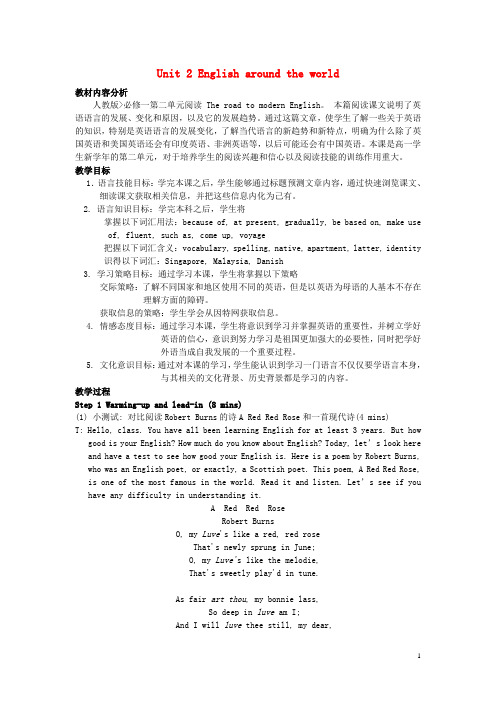
Unit 2 English around the world教材内容分析人教版>必修一第二单元阅读The road to modern English。
本篇阅读课文说明了英语语言的发展、变化和原因,以及它的发展趋势。
通过这篇文章,使学生了解一些关于英语的知识,特别是英语语言的发展变化,了解当代语言的新趋势和新特点,明确为什么除了英国英语和美国英语还会有印度英语、非洲英语等,以后可能还会有中国英语。
本课是高一学生新学年的第二单元,对于培养学生的阅读兴趣和信心以及阅读技能的训练作用重大。
教学目标1.语言技能目标:学完本课之后,学生能够通过标题预测文章内容,通过快速浏览课文、细读课文获取相关信息,并把这些信息内化为己有。
2. 语言知识目标:学完本科之后,学生将掌握以下词汇用法:because of, at present, gradually, be based on, make use of, fluent, such as, come up, voyage把握以下词汇含义:vocabulary, spelling, native, apartment, latter, identity 识得以下词汇:Singapore, Malaysia, Danish3. 学习策略目标:通过学习本课,学生将掌握以下策略交际策略:了解不同国家和地区使用不同的英语,但是以英语为母语的人基本不存在理解方面的障碍。
获取信息的策略:学生学会从因特网获取信息。
4. 情感态度目标:通过学习本课,学生将意识到学习并掌握英语的重要性,并树立学好英语的信心,意识到努力学习是祖国更加强大的必要性,同时把学好外语当成自我发展的一个重要过程。
5. 文化意识目标:通过对本课的学习,学生能认识到学习一门语言不仅仅要学语言本身,与其相关的文化背景、历史背景都是学习的内容。
教学过程Step 1 Warming-up and lead-in (8 mins)(1) 小测试: 对比阅读Robert Burns的诗A Red Red Rose和一首现代诗(4 mins)T: Hello, class. You have all been learning English for at least 3 years. But how good is your English? How much do you know about English? Today, let’s look here and have a test to see how good your English is. Here is a poem by Robert Burns, who was an English poet, or exactly, a Scottish poet. This poem, A Red Red Rose, is one of the most famous in the world. Read it and listen. Let’s see if you have any difficulty in understanding it.A Red Red RoseRobert BurnsO, my Luve's like a red, red roseThat's newly sprung in June;O, my Luve's like the melodie,That's sweetly play'd in tune.As fair art thou, my bonnie lass,So deep in luve am I;And I will luve thee still, my dear,Till a' the seas gang dry.Till a' the seas gang dry, my dear,And the rocks melt wi' the sun;I will luve thee still, my dear,While the sands o' life shall run.And fare thee well, my only Luve!And fare thee well, a while!And I will come again, my Luve,Tho' it were ten thousand mile!T: Did you find it easy or difficult? What about this one? This poem was written by a modern writer.I Am Not YoursI am not yours, not lost in you,Not lost, although I long to beLost as a candle lit at noon,Lost as a snowflake in the sea.You love me, and I find you stillA spirit beautiful and bright,Yet I am I, who long to beLost as a light is lost in light.Oh plunge me deep in love—put outMy senses, leave me deaf and blind,Swept by the tempest of your love,A taper in a rushing wind.T: Why is the first poem difficult to understand while the second one not? (Mainly because of some of the words used in the first poem, which are not often used now. Robert Burns lived in the 18th century while the writer of the second poem is a modern poet.) So we can see people in the past used different words from what is used today.(2) 听一段一位学生和来自澳大利亚的外教的对话(4 mins)T: Now, when one day Qiu Zhensong met our foreign teacher Zak, who is from Australia, what happened? Let’s welcome Zak and Qiu Zhensong.(After the dialogue, the foreign teacher explained.) Did you understand our dialogue? (Ss: No.) What’s the difficulty? (Different words were used in Australia which you do not know in American or British English.) T: So from the two poems and the dialogue we can see people from different countries speak different English and people in different times also use different English. How did the difference come about?[意图说明] 引入话题:不同时代、不同国家所使用的英语有所不同。
人教版高中英语必修一 第二单元 教学设计
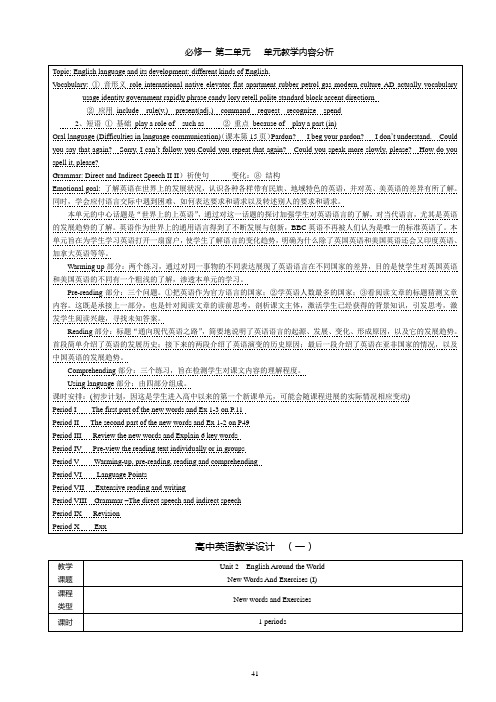
课时安排:(初步计划,因这是学生进入高中以来的第一个新课单元,可能会随课程进展的实际情况相应变动)
Period IThe first part of the new words and Ex 1-3 on P.11
Period IIThe second part of the new words and Ex 1-2 on P49
Finish the Exx individually or in groups
本节课中的重点与中心环节,希望通过本节的设置,能让学生在实际运用中较为有效的识记单词,体会语用的功效。
min
Step 6
Checking
If time permits,Check the answers
Check the answers and correct their own.Try to be clear why they are right or wrong.
教学
重点
1 Pronounce the new words and expressions correctly. 2 Grasp the use of some key words.
3 Learn at least one way to memorize new words and expressions
学情
分析
Ss have poor vocabulary, and the worse is that they still don’t have an essential way to enrich their vocabulary.So, this period will help them to realize how to memorize words in practical using.
高中英语人教版(2019)必修第一册Welcome unit Period 2 Reading and Thinking优秀教学设计

Welcome Unit
Period 2 Reading and Thinking:First Impressions
教学设计
教材分析
本节课是高中英语第一册Welcome Unit的阅读和思考部分,这个单元是刚刚步入高中阶段的开始,所以是初高中的过渡,让学生逐渐适应高中阶段的节奏和生活,对比初中来找寻不同之处,从而尽快适应新的生活。
从阅读意识的培养上,让学生了解叙事体裁需要一定的顺序,让文章更有层次感。
最后,在读的过程中了解一些必须掌握的词汇。
教学目标与核心素养
语言能力目标
新课标对于高考语篇意识非常重视,其中的叙事类型学生并不陌生,只是没有从宏观把握的习惯,这节课内容虽然很简单,但是可以借此培养他们对叙事顺序的思考,帮助他们具有一定的语言意识和英语语感,在常见的具体语境中整合性的运用已有的语言知识。
思维品质目标:
通过对比主人公的高中生活和自己的高中生活来寻找相同点和不同点,建立高中学习目标,树立远大理想并正确评价各种思想观点。
同时通过对文章信息的重新整合,做到创造性地表达自己的观点,具备初步运用英语进行独立思考的能力。
教学重难点
1.重点
(1)通过skimming 的方式快速找出文章的叙述顺序;
(2)学会用已知的内容去解决未知的问题,用已经了解的词汇去学习新的词汇;
2. 难点
(1)可以分辨叙述顺序,并可以换一种顺序来叙述;
(2)学会寻找一段中的关键词来重复故事。
教学过程。
Unit 2 Reading for Writing教学设计-高中英语人教版(2019)必修第一册
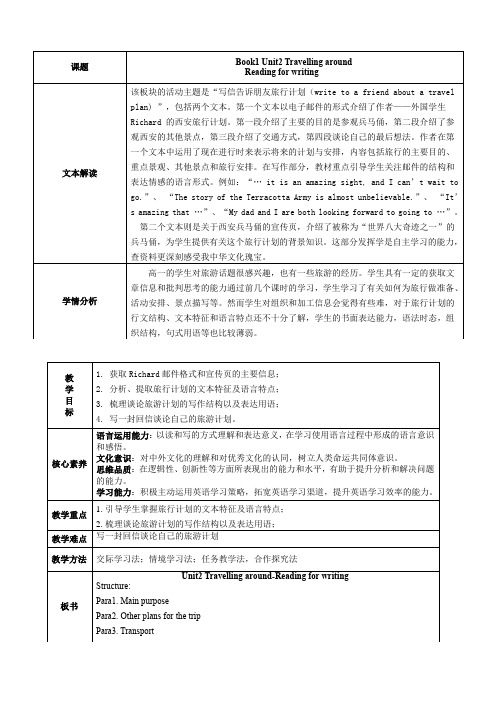
Step3 Reading
T: Ask students to read the email and summarize the main idea of each paragraph.
1.Main purpose for the trip
2.Other plans for the trip
3.transport
再次阅读文本,回答每段段意,掌握文本细节信息,培养学生对信息筛选,分析,归纳总结的能力
详细阅读每一段,梳理文章结构信息及语言特点,从宏观到微观,学生掌握文本的组织形式,内容安排,学习仿写
环节五
Step5 Writing
T:Ask students to write an email to Richard and talk about your own travel plan.
be planning to/be going to…
The reason for your plan: amazing
I’ve heard that... and I can’t wait to go.
It is an amazing sight…
…is almost unbelievable.
Other plans for the trip
·A specific purpose?
·A fixed layout(格式)?
·Appropriate language?
·Neat handwriting?
·Does each paragraph have a clear main idea?
·Does the writer use the present continuous tense for future plans?
Unit 2 Reading and Thinking 教学设计人教版(2019)必修第一册
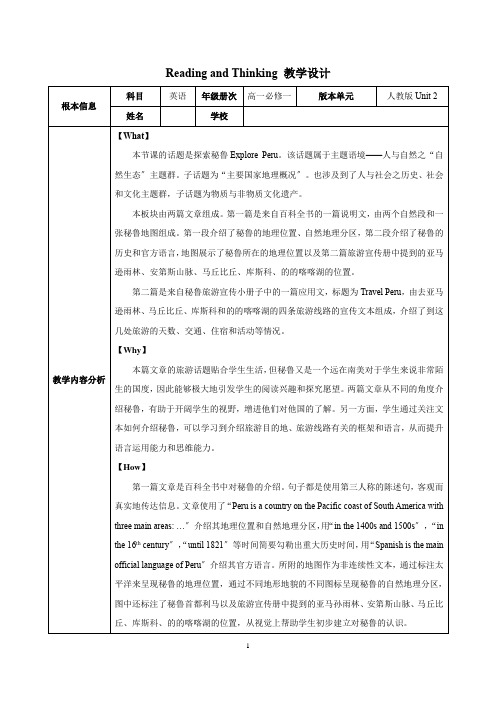
Haveyou ever traveled to Peru?
Canyou find Peru in the map?
What do you know aboutPeru?
2.学生观看数字教材第26页活动1视频Welcometo Peru,并答复下列问题:
汇报交通:Travelers will get thereby planeand travelby boat.
汇报住宿:Travelers will live inthe middle of the forest.
汇报活动:Travelers willgo boating,go hikingandexplore naturethere.
基于主题,引导学生整合重点信息
基于已经获取的信息,引导学生思考更多和介绍旅游国家、旅游线路有关的角度,扩展学生思维
帮助学生内化和秘鲁以及秘鲁旅游有关的语言
概括与整合
概括与整合
内化与运用
3.谈论自己去过的国家〔地区〕
学生根据思维导图谈论自己去过的一个国家或地区。
学生运用所学的语言和结构对接自己的实践来进行表达。
4.查找自己去过的一个国家或地区的旅游信息,仿照书上的第二篇文章写一段旅游线路介绍。
激活学生的和地理相关的词汇如South America, the Pacific Ocean等;
教师初步引出和秘鲁有关的新词汇〔具体要看视频〕
引发学生初步关注信息的来源,引出encyclopedia, brochure等词汇,为之后识别语篇类型做准备。
引导学生关注两篇文章的语言特点,识别语篇类型,初步学习地名the Pacific Ocean,the Andes Mountains, the AmazonRainforest, Machu Picchu, Cusco, Lake Titicaca等。
人教版高中英语必修一Unit2说课稿
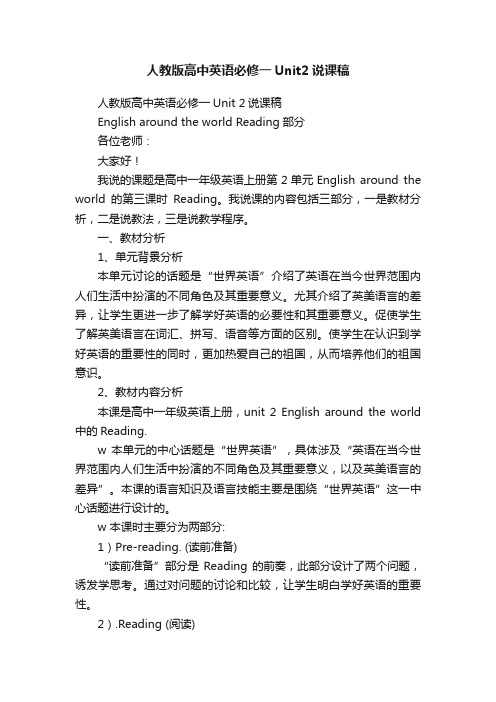
人教版高中英语必修一Unit2说课稿人教版高中英语必修一Unit 2说课稿English around the world Reading部分各位老师:大家好!我说的课题是高中一年级英语上册第2单元English around the world的第三课时Reading。
我说课的内容包括三部分,一是教材分析,二是说教法,三是说教学程序。
一、教材分析1、单元背景分析本单元讨论的话题是“世界英语”介绍了英语在当今世界范围内人们生活中扮演的不同角色及其重要意义。
尤其介绍了英美语言的差异,让学生更进一步了解学好英语的必要性和其重要意义。
促使学生了解英美语言在词汇、拼写、语音等方面的区别。
使学生在认识到学好英语的重要性的同时,更加热爱自己的祖国,从而培养他们的祖国意识。
2、教材内容分析本课是高中一年级英语上册,unit 2 English around the world 中的Reading.w 本单元的中心话题是“世界英语”,具体涉及“英语在当今世界范围内人们生活中扮演的不同角色及其重要意义,以及英美语言的差异”。
本课的语言知识及语言技能主要是围绕“世界英语”这一中心话题进行设计的。
w 本课时主要分为两部分:1)Pre-reading. (读前准备)“读前准备”部分是Reading的前奏,此部分设计了两个问题,诱发学思考。
通过对问题的讨论和比较,让学生明白学好英语的重要性。
2).Reading (阅读)“阅读”部分文体为说明文,全文共分三个段落。
全文阐述了一个鲜明的观点:英语的确是当今世界范围内使用最广泛的一门语言之一,也是联合国的工作语言之一,它的重要作用是其他语言不可替代的。
3)Post-reading(读后)“读后”部分共设计了两类题型:第一部分是和个问题,其中前面两个是细节理解题;第三题是一个开放性题目,鼓励学生把英语学习与现实生活相结合。
第二部分是填空形式,帮助学生梳理文章,掌握文章主要细节,概括中心思想,实为文章的一个纲要。
人教版高中英语必修一教案:Unit2EnglandaroundtheworldReading
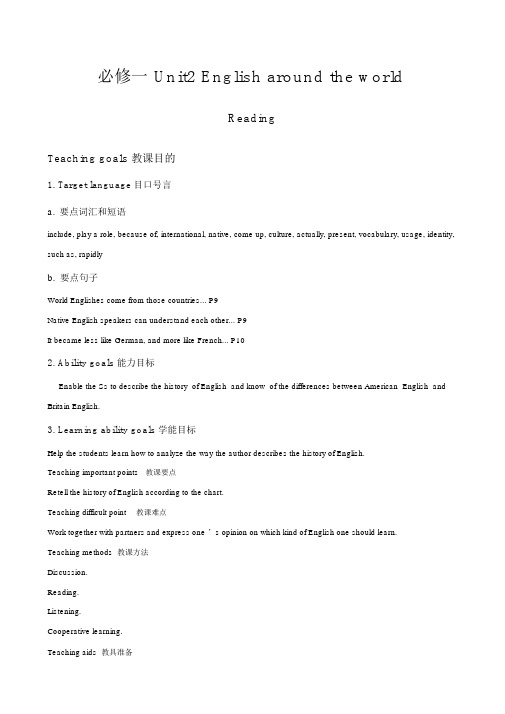
必修一 Unit2 English around the worldReadingTeaching goals 教课目的1. Target language目口号言a.要点词汇和短语include, play a role, because of, international, native, come up, culture, actually, present, vocabulary, usage, identity, such as, rapidlyb.要点句子World Englishes come from those countries... P9Native English speakers can understand each other... P9It became less like German, and more like French... P102. Ability goals能力目标Enable the Ss to describe the history of English and know of the differences between American English and Britain English.3. Learning ability goals学能目标Help the students learn how to analyze the way the author describes the history of English.Teaching important points教课要点Retell the history of English according to the chart.Teaching difficult point教课难点Work together with partners and express one ’s opinion on which kind of English one should learn.Teaching methods 教课方法Discussion.Reading.Listening.Cooperative learning.Teaching aids 教具准备A recorder, a projector and some slides.Teaching procedures & ways教课过程与方式Step I Greeting and revisionT:Good morning / afternoon, boys and girls! First I will check the words and expressions you have previewed.(P11-12 Discovering useful words and phrases part 1, 2, 3, and 4)Teacher shows answers on the screen.T: Please look at the screen and check your answer. Do you have any question?S: Are“ such as” and“ for example” the same?T: OK, I’ ll give you two examples:1.He knows five languages, such as Russian, French and Spanish.2.The differences in the spoken language are greater.S: Oh, I see. Such“as” is used to list similar things, while“ for example” is used to prove the speakers w Ss ask any questions and Teacher explains to them in class.Step II Warming upArouse the Ss’interests in reading. Let the students know of world English.T:So much for the words. Can you name some countries in which English is spoken?Ss: Of course. America, Britain, Canada, Australia...Teacher writes American, British, Canadian, and Australian on the Bb. Then add English to these words.T:Are these Englishes the same?S:I think they are the same. They are all called English.S:I don’t think so. As I know BE and AE are different in spelling, pronunciation and so on.T:Well, turn to page 9. Read the warming up. Please answer the questions below.Ss: (scanning) There is more than one kind of English.T:Please go on reading and try to tell AE words from BE words below.After reading the students give their answers.T:Who will show your answer?S: I think um,“m in a team, rubber, petrol” are BE words“mom,.And on a team, eraser, gas” are AE words.T:Can you give them a name?Ss: World English.T:Very good.Step III Pre-readingActivate the Ss ’background knowledge of English.T:From Warming up we know many people speak English in the world. How many people speak English andwhy do so many people speak English? Please discuss with your partners and answer the questions.A few minutes later.S:Maybe 1000 million people speak English today. Because many countries were colonies of England so Englishis spoken as a first or second language in many countries.S:We can ’t get the exact number. More and more people begin to learn English because English is theworking language in the United Nations. Everywhere children go to school to learn English.T: Excellent! About 1500 million people speak English as their first, second or foreign language. But they’tdon speak the same kind of English.Step IV ReadingGet the students to know the history of English and help the Ss to form a good habit of reading.Point to the Bb.T: How did different kinds of English come about? Please read the text“ The Road to Modern English”and pick out the answer.Ss read quickly to find the answer.T: Any volunteer to answer the question?S: I will. English has changed over time. All languages change when cultures communicated with one another.T: Any different ideas?Well, you all have the same answer.Task1 Reading and choose correct answers.T:Turn to page 10. Please read the questions and multiple answers first to know what information we should get,and then read the passage to find the answer.S:I will. English has the most speakers now.T:Good. What ’s the answer to the second?S:Languages change when cultures change.T: Right. How do you know?S:I judge it, according to the second sentence in the third paragraph.T:Good. Can you choose the right answer to question 3 ?S:Yes. From AD 450 to1150 English sounds more like German.T:Excellent. What about question 4?S:Around 1600 ’s.T:Very good. The last one? Let ’s answer ittogether. Ss: China.T:You are quite right.Task2 Read and summarize the main idea of each paragraph. Work in groups of four.T:Read the text and tell the main idea of each paragraph. After reading, discuss your answer in groups of four.After a few minutes.T: What ’s the main idea of the first paragraph?S1: The first paragraph tells us that more and more people speak English.S2: I don’hinktt so. It describes the extension of English in the world.T: Right. The first paragraph describes the extensive of English in the world. What is the main idea of paragraph 2?S: It tells us native speakers can understand each other but not everything.Let the Ss give an example to prove this point.T: Can you tell me what the third paragraph is about?S:All languages change when cultures communicate with one another. It’s the key sentence of the last two paragraphs. This paragraph tells the development of English as native language.T:Quite right. What about the last paragraph?S:English is spoken as a foreign or second language in many countries.T:How many parts can we divide the text into ?S:Two parts. The first paragraph is the first part, and paragraph 2, 3 and 4 can be part 2.Task3 Analyze the text.T:Please read the text again to tell the main idea of each part and the function of each paragraph. Afterreading please fill in the chart below.DiscussionS1: The first part describes the history of English in chronological order: 16th century-the next century— today.S2: It describes the development of English from the angle of its extension in region. Look, England—many other countries — more people than before (China).S3: I agree with S2.S4: In part two, the author first raises the fact: English has changed over time. Then analyze how English haschanged into world English.T:Are you ready? Which group would like to fill the chart? Group 1 please writes down the main idea of each part. Group 2 please write the function of paragraph 1and2. Group3, the last two paragraphs. The other students check their answers.Sample chart (slide)Part Paragraph FunctionPart1:12Part2:34Suggested answersPart Paragraph FunctionPart1:The extension of English1Describe the development ofin the world English from the angle of itsextension in region.England— many othercountries—more people thanbefore (China).Part2:English changes when2Raise the fact: English hasits culture communicate with developed into world Englishothers3Describe the development ofEnglish in English speakingcountries.4Describe the development ofEnglish in countries where it isspoken as a foreign or secondlanguage.Step V Post-readingCheck the Ss’understanding of the text, help the Ss deal with new language points.Task Express one’s own opinion. Work in groups of four.T:There are many kinds of English. Which kind of English are we learning?Ss: Both AE and BE.Show questions on the screen and ask a student to read them.T: Please discuss these questions and tell us your answers.1.Do you think it matters what kind of English you learn? Why?2.Why do you think people all over the world want to learn English?3.Will Chinese English become one of the world English?After a few minutes.T:OK, I ’ ll ask some groups to report their opinions. Group 1, can you tell us your opinion?S:Yes. I think we should learn BE because other kinds of English came from it.T:Any different ideas?S: In my opinion, we can learn any kind of English because people can understand each other even if they don’t speak the same kind of English.T: Wonderful! What about the second question?S:With the development of economy, it is necessary for people from different countries to communicate witheach other. So we need a language to be work language, while English is the most widely used language. So people all over the world want to learn English.T:Very good! What ’s your opinion?S:I think because of the wide use of computer, people have to learn English. Computer plays an important partin the popularity of English.T:OK. Question 3.Yes or no ?S:My answer is “ yes ”A . large number of Chinese especially young people are learning English. English is communicating with Chinese culture. There will be Chinese English.T:Only time will tell. Now we know English is spoken in so many countries and it plays an important part in the world. If we learn English well, we can listen to English song, read English novels, travel in English speaking countries comfortably and communicate with foreigners easily. Also, it is of great help not only to our own development but also to the development of our country. The Olympic Games will be held in Beijing. Let’s work hard and welcome its coming.Question timeT:It ’ s time for you to ask any questions or let me explain the sentences that hinder your understanding of the text. Ss ask questions freely.T:Now let ’s deal with some language points. Turn to page 9. Let ’ s look atthe sentence: However, they may not understand everything. This sentence means that sometimes they can understand each other, but sometimes theyhave difficulty understanding each other. The English spoken between about AD 450 and 1150 was very differentfrom the English spoken today. In this sentence,“ spoken between about AD 450 and 1150” and“are used to describe the English.HomeworkRetell the text according to the chart.Finish exercises1, 2, 3 (Using words and expressions) P49-50.。
Unit2TravellingAroundReadingforWriting教学设计-高中英语人教版

必修一Unit 2 Travelling Around Reading for Writing1. Get students to have a good understanding of how to write an impressive travel plan2. Enable students to use some writing skills flexibly.3. Develop students’ writing and cooperating abilities.4. Strengthen students’ great interest in writing discourses.教学重难点1. Guide students to write a concise, coherent and structured email, introducing their own travel plans.2. Guide students to properly convey emotions using the proper language.教材分析:第一个文本以电子邮件的形式介绍了作者的西安旅行计划。
作者运用了现在进行时来表达将来的计划与安排,该文本的语言轻松随意,是年轻朋友之间的交流。
第二个文本是关于兵马俑的宣传页,介绍了兵马俑的基本情况,以此为学生提供有关这个旅行计划的背景知识。
通过两个文本引导学生写一份语言简练,语义连贯,结构清晰的电子邮件,介绍自己的旅行计划,并能恰当的融入表达情感的语言结构。
教学过程Step 1: PrewritingThe teacher asks students to discuss the topic freely with their partners and brainstorm some ideas concerning the topic.Q1: how to write to your friend an impressive travel plan?Q2: What kinds of aspects should be included?设计意图:通过这一步骤, 激活学生思维,避免学生在刚开始上课时疲惫或紧张。
2.2 Reading and thinking 教学设计(2)-人教版高中英语必修第一册
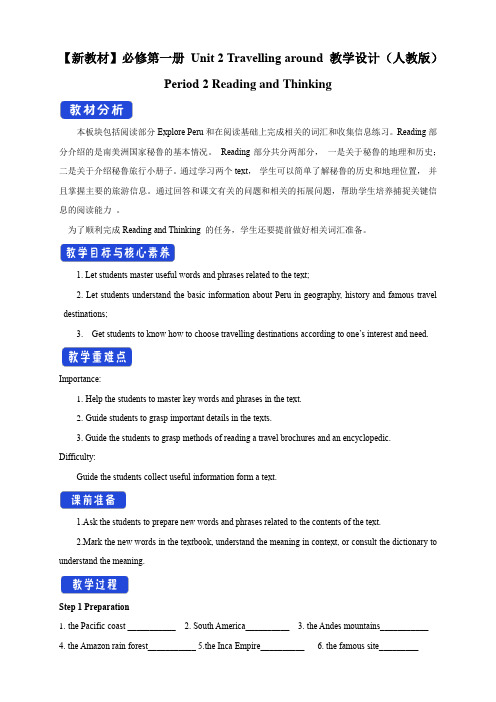
【新教材】必修第一册Unit 2 Travelling around 教学设计(人教版)Period 2 Reading and Thinking本板块包括阅读部分Explore Peru和在阅读基础上完成相关的词汇和收集信息练习。
Reading部分介绍的是南美洲国家秘鲁的基本情况。
Reading部分共分两部分,一是关于秘鲁的地理和历史;二是关于介绍秘鲁旅行小册子。
通过学习两个text,学生可以简单了解秘鲁的历史和地理位置,并且掌握主要的旅游信息。
通过回答和课文有关的问题和相关的拓展问题,帮助学生培养捕捉关键信息的阅读能力。
为了顺利完成Reading and Thinking 的任务,学生还要提前做好相关词汇准备。
1. Let students master useful words and phrases related to the text;2. Let students understand the basic information about Peru in geography, history and famous travel destinations;3. Get students to know how to choose travelling destinations according to one’s interest and need.Importance:1.Help the students to master key words and phrases in the text.2.Guide students to grasp important details in the texts.3. Guide the students to grasp methods of reading a travel brochures and an encyclopedic.Difficulty:Guide the students collect useful information form a text.1.Ask the students to prepare new words and phrases related to the contents of the text.2.Mark the new words in the textbook, understand the meaning in context, or consult the dictionary to understand the meaning.Step 1 Preparation1.the Pacific coast ___________2. South America__________3. the Andes mountains___________4. the Amazon rain forest___________5.the Inca Empire__________6. the famous site_________7. an official language___________8. accommodation___________ 9. destination __________ 10. local Indian culture___________ 11. the architecture___________ 12.local markets___________ Step 2 Warming upGive the students some information about a country and encourage them to guess which country it is. Choose which of the countries is being discussed according to the following information.1)There used to be a famous empire here.2)The country has long coast and famous for its unique scenery3)Part of the country is covered with rainforests.4) It is one of the South American Countries.A. ChinaB. CanadaC. PeruD. Russia ( C)Step 3 Explore PeruBefore carrying out the task, remind the students to pay attention to the tip.Before you read look through the text quickly for titles, headers, pictures, charts and any other information that might tell you what type type of text it is.Task 1 : Encyclopedia or Brochure?Get the students to look through the two passages about Pero while listening carefully.Encourage the students to judge what types of texts they are: encyclopedia or brochure.The first text:It is an encyclopedia because it focuses on basic geographic and historical information.The second text:It is a travel brochure because it mainly introduces local travel information. Besides, there is contacting information at the end of the text.Task 2 : Reading and observingGet the students to read the first text in detail and pay attention to details in its history and then observe the map of Peru to know about its location and geography features.Information from the first text:on the Pacific coast of south Americathree main areasIn the 1400s and 1500s, the center of the powerful ancient Incan empire.Spain took control in the seventeen sixteen century.the official language—SpanishInformation from the second text:Amazon Rainforest Tour:rain foresttraveling by boatexploring the rain forest with a local guideenjoying the plants and animalsMachu Picchu Tour:a four- day walking tour on amazing paths.enjoy the unique Spanish and local Indian cultureCusco Tour:the unique square and local Indian culturethe capital of the Inca Empirestay in local hotelvisit the museumsadmire the architectureenjoy excellent local foodgo shopping at the Local markets.Lake Titicaca Tour:the beautiful countrysidethe new highwaystay with a local Uros familyAn island and the Uros homes made of water plantsTask 4 Complete the passage with the correct forms of the new words from the texts.Get the students to read the passage and fill in the blacks. Remind the students pay attention to the first letters of each words.Cusco is a popular _destination __ for tourists. Because of its ___ unique __place in the history of South America. Cusco was the capital city of the Inca__Empire__ which was the most powerful in South America until the 1500s. There are two especially interesting things to__ admire __ about the Inca civilization. The first is the roads and __paths__, they built to connect their important cities. These Inca roads were made up of two north- south highways and many small roads crossing the mountains east to west. The roads were for Inca soldiers and their ___officials__. Second, the Inca built wonderful cities full of amazingarchitecture, but there were no markets in these cities. One of the interesting questions of history is how the Incas lived without shopping!Task 5 Information collectionGet the students to read the text and fill in the table.Encourage the students to discuss the question below with a partner.Guide the students to use the information in the text to give reasons.Which tour(s) would you recommend for people who enjoy history and culture. Why ?1、通过本节的阅读和思考活动,希望逐渐能够培养学生阅读实用文体,如旅游手册的时候,关注关键信息的能力。
高中英语人教版必修第一册Unit 2 Reading for Writing 写作课教案-

Write to a friend about a travel plan写作课教案1.Teaching Objectives(1)Students can understand the passage and master some basic writing skills.(2)Students can write a concise and well-organised travel plan.(3)Students can develop their writing and cooperating abilities.(4)Students can develop the habit of planning their work.2.Teaching Key and Teacning Difficult PointTeaching key points : Students can understand the passage and master some basic writing skills. Teaching difficult points : Students can write a concise and well-organised travel plan.3.Teaching ProceduresStep 1 Lead-in (5 minutes)Discuss the following questions:●What do you do to prepare before you travel?●Do you make a travel plan before you go on a trip?●What are included in a travel plan?(Justification:this step can attract student’s interest and introduce the topic.)Step 2 pre-writing (8 minutes)1)Ask students read the letter and summarize the main idea of each pargraph.Para 1: Purpose of the tourPara 2: Other planPara 3: TransportionPara 4: Looking forward to hearing back2)Ask students read the letter again and find out the main elements of a travel plan. (Justification:this step can provide some background information and pave the way for the following activities.)Step 3 while-writing (20 minutes)1)Ask students to draft a reply based on the main elements of a travel plan.2)After drafting, ask students read their own passage and check for grammatical errors andlogical problems.(Justification: This step can help students organize their ideas and words into their drafts.)Step 4 post-writing(10 minutes)1)Ask students to exchange their writing with destmates, they need to check each other’swriting based on content and structure and give advice.2)Choose several students to share their essays, give them some evaluation and conclude theirmerits and demerits.(Justification: This step can help students consolidate what they have learned and help they learn from each other.)4.Homework (2 minutes)Share your travel with your family and ask whether they have any advice.。
新人教版高中英语必修一Unit 1 Period 2 Reading and Thinking教案
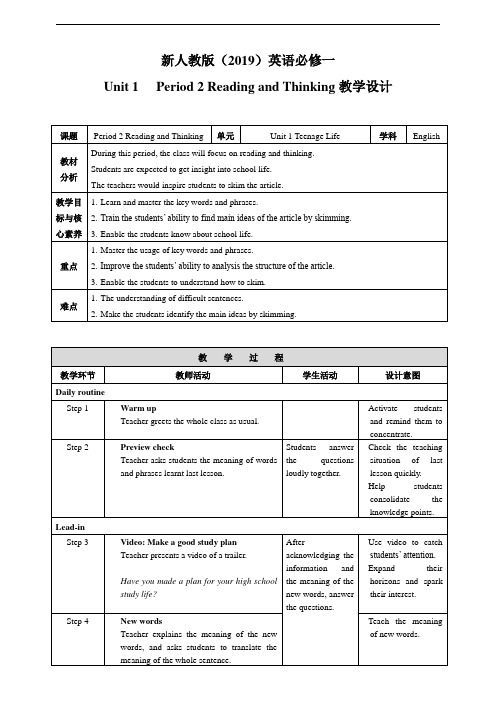
新人教版(2019)英语必修一Unit 1 Period 2 Reading and Thinking教学设计3.Adam will have to study harder in thefuture and get used to beingresponsible for a lot more.Read the text again and answer the questions.What courses did Adam choose? Which one do you think would be his favorite? Why?What does "make the team" in Paragraph 3 mean?What is Adam worried about?Is Adam confident that he will get used to senior high school life? How do you know?1.Adam chose math, English, chemistry,world history, and Chinese. Advancedliterature would be his favoritesubject because he likes English andhe is good at it.2.“Make the team” means to try outand then be allowed to join a sportsteam.3.He is worried about keeping up withthe other students in his advancedcourse and getting used to all thehomework.Complete the outline.DiscussionIn pairs, discuss the following questions.make a good decision.We can try a course for two weeks after we___________ up for it. After that, we cannot change it.The main purpose of the course is to help __________ each student's reading ability. Some of the students want to become writers or editors after they __________, so the teacher advised them to start a writing club.The school is __________ for the safety of all the students.Whenever I'm facing a difficulty, I always tell myself, "Don't let anything stop you. Don't ever __________.”keys:1.recommended2.challenge3.confusing4.sign5.improve6.graduate7.responsible8.quitStep 8 SkimYou can find main ideas by first taking aquick Look at the title, picture(s), key wordsand phrases, and topic sentences.Which paragraph is the main part?Which paragraphs are the supportingparts?SkimmingSkimming is the process of quickly viewinga section of text to get a general impression Discuss with theirpatterner and thenshare their ideas.-Voice their opinions.-Practice their teamspirit.-Practice theirthinking skill andimagination.-Practice theirspeaking andlistening.。
【新教材】2.2 Reading and thinking 教学设计-人教版高中英语必修第一册

Get the students to read the passage and fill in the blacks. Remind the students pay attention to the first letters of each words.
4days
4days
4days
Transport
by boat
on foot
by car / by boat
Accommodation
in the middle of the forest
a local hotel
local home
Activity
explore the rain forest with a local guide.
7. an official language___________8. accommodation___________ 9. destination __________
10. local Indian culture___________ 11. the architecture___________ 12.local markets___________
Before you read look through the text quickly for titles, headers, pictures, charts and any other information that might tell you what type type of text it is.
Unit-2-Reading-and-Thinking教案--人教版高中英语必修第一册

新人教版必修一Unit 2 Reading and Thinking教案课题UNIT 2 TRA VELLING AROUNDPeriod 2 Reading and Thinking学科英语班级授课教师教学目标1. Students can learn about the famous scenic spots and cultural features of Peru.2. Read an encyclopedia entry and travel brochure about Peru for more details.3. Practise the skill of identifying the types of the two texts about Peru.4. Students can learn some new words and expressions and use them in the context.教学主题该板块的教学主题是“探索秘鲁”(Explore Peru)。
学生通过观看视频、阅读有关南美洲国家——秘鲁的介绍和旅游宣传册,了解秘鲁的旅游资源,同时了解这个国家的地理、历史、文化及景观等内容,最后要完成根据游客的兴趣爱好推荐合适的旅行路线的任务。
该板块的活动模拟现实生活中人们通过阅读旅游宣传册或者其他如百科全书式的介绍性文本来了解旅行目的地的过程,让学生学会从不同渠道搜寻信息,为制订旅行计划做好准备。
教科书选择具有南美风情和特色的国家——秘鲁为目的地,增加了学生了解非英语国家的机会,使其拥有更广阔的国际视野。
该部分除了文字以外,还提供了图片、地图、视频等多模态形式的语篇,培养其看的能力。
教学重点引导学生掌握介绍性文本和旅游宣传册的结构特征、文体特征及语言特点,了解秘鲁旅游资源及文化特色,形成个人见解。
教学难点1. 让学生快速阅读语篇以获取文章关键信息,预测文本内容,概括段落大意。
2024年人教版高一英语必修一unit2教案

2024年人教版高一英语必修一unit2教案一、教学目标知识与技能学生能够掌握本单元的基本词汇和表达,包括描述人物特征、爱好、日常活动等。
学生能够熟练运用本单元的重点句型,进行简单的自我介绍和询问他人信息。
学生能够理解并运用本单元的阅读材料,获取文章中的关键信息。
过程与方法培养学生通过合作学习,共同解决问题的能力。
鼓励学生通过小组讨论、角色扮演等方式,积极参与课堂活动,提高英语应用能力。
引导学生在完成课堂任务的过程中,学会自主学习和探究学习。
情感、态度和价值观激发学生学习英语的兴趣和热情,增强他们的自信心。
帮助学生树立积极向上的学习态度,鼓励他们勇敢面对挑战。
培养学生的跨文化意识,使他们能够尊重并理解不同文化背景的人。
二、教学重点和难点教学重点本单元的重点词汇和表达,如描述人物特征的形容词、谈论日常活动的动词短语等。
本单元的重点句型,如使用“be good at”谈论某人的特长,使用“spend time doing sth.”描述日常活动等。
阅读材料的理解和应用,包括从文章中提取关键信息、理解作者的意图等。
教学难点对于某些生僻词汇的理解和记忆。
对于某些复杂句型的掌握和运用。
在阅读材料中,对于深层含义和文化背景的理解。
三、教学过程导入新课通过展示一些图片或视频,引导学生讨论图片中的人物特征、活动等,激发他们的兴趣和好奇心。
提出一些与本单元主题相关的问题,让学生思考并回答,为后续的学习做好铺垫。
词汇和句型学习教师呈现本单元的生词和短语,并解释其意义和用法。
通过例句和练习,让学生熟悉并掌握本单元的重点句型。
鼓励学生运用新学的词汇和句型进行自我介绍或描述他人,以检验他们的掌握情况。
阅读理解教师引导学生阅读本单元的阅读材料,并帮助他们理解文章的大意和细节。
通过提问和讨论的方式,让学生分析文章的结构、作者的意图以及文章中的深层含义。
鼓励学生将阅读材料与自己的生活经历联系起来,进行拓展思考和表达。
语法讲解与练习教师对本单元的语法知识进行系统讲解,包括时态、语态、非谓语动词等。
高中英语必修一unit2教案教学设计(一)

高中英语必修一unit2教案教学设计(一)高中英语必修一 Unit 2 教学设计教学目标•掌握本单元重点词汇和短语的读音、拼写和用法。
•熟练运用本单元的语法知识,能够正确运用一般现在时和一般过去时进行句子构建。
•能够理解并正确运用本单元的重点语言知识和交际用语。
教学重点•重点词汇和短语的掌握和运用。
•一般现在时和一般过去时的句子构建。
•口语和书面表达的实际应用。
教学准备•教科书:必修一 Unit 2•多媒体设备•单词卡片和图片教学过程Step 1:导入新课1.引入新课前,请学生预习相关内容,了解本单元的主题和基本内容。
2.利用多媒体设备播放与主题相关的图片或视频,激发学生的兴趣。
Step 2:语言输入1.根据教材内容,进行重点词汇和短语的讲解,并请学生跟读。
–重点词汇:(列举词汇列表)–重点短语:(列举短语列表)2.通过示范句子,引导学生学习使用一般现在时和一般过去时的句子构建。
–一般现在时:(示例句子)–一般过去时:(示例句子)3.练习语言输入,让学生进行口头对话练习,以巩固新学的词汇和句型。
Step 3:语言输出1.分组活动,让学生根据教材中的对话内容进行角色扮演,模拟真实情境,练习运用所学语言知识。
2.激发学生的创造力,让他们用一般现在时或一般过去时构建有关自己生活经历的句子。
3.学生之间进行交流,分享自己的句子,并互相给予反馈和建议。
Step 4:巩固练习1.在教室内,贴出单词卡片或图片,让学生进行词汇和短语的默写练习。
2.通过听力练习和阅读理解练习,检测学生对本单元语言知识的掌握情况。
3.布置相关练习作为课后作业,以查漏补缺。
Step 5:总结和归纳1.回顾本节课学习的重点和难点内容,做一个简单总结。
2.与学生一起梳理本单元的重点知识和技能,强化学习效果。
教学延伸•鼓励学生多阅读与本单元主题相关的文章或故事,拓宽他们的语言和文化视野。
•提供更多的口语练习机会,如角色扮演、小组讨论、辩论等。
Unit2 教学设计-【新教材】人教版高中英语必修第一册
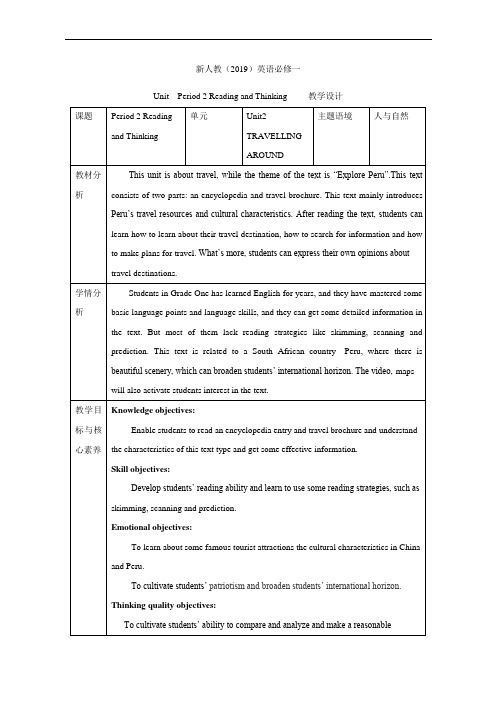
教学目标与核心素养
Knowledge objectives:
Enable students to read an encyclopedia entry and travel brochure and understand the characteristics of this text type and get some effective information.
share their own opinions.
难点
How to let students compare the four different places and give specific suggestions.
教学资
源:
multimedia
教学准
备:
Some background for Peru
重点
1.Toenable students to learn about the characteristics andlinguistic featuresof encyclopedia and travelbrochure
2.TomakestudentslearnaboutthetravelresourcesandculturalfeaturesofPeru,and
教ห้องสมุดไป่ตู้方法:
Task-based teaching method;
Fast reading to get the general idea of the passage
Careful reading to get some detailed information in the passage
人教版高中英语必修一unit-2-reading教学设计说明
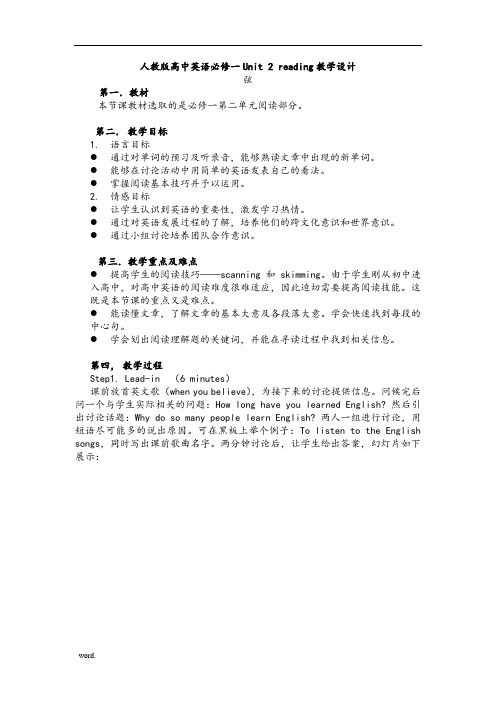
人教版高中英语必修一Unit 2 reading教学设计弦第一.教材本节课教材选取的是必修一第二单元阅读部分。
第二.教学目标1.语言目标●通过对单词的预习及听录音,能够熟读文章中出现的新单词。
●能够在讨论活动中用简单的英语发表自己的看法。
●掌握阅读基本技巧并予以运用。
2.情感目标●让学生认识到英语的重要性,激发学习热情。
●通过对英语发展过程的了解,培养他们的跨文化意识和世界意识。
●通过小组讨论培养团队合作意识。
第三.教学重点及难点●提高学生的阅读技巧——scanning 和 skimming。
由于学生刚从初中进入高中,对高中英语的阅读难度很难适应,因此迫切需要提高阅读技能。
这既是本节课的重点又是难点。
●能读懂文章,了解文章的基本大意及各段落大意。
学会快速找到每段的中心句。
●学会划出阅读理解题的关键词,并能在寻读过程中找到相关信息。
第四,教学过程Step1. Lead-in (6 minutes)课前放首英文歌(when you believe),为接下来的讨论提供信息。
问候完后问一个与学生实际相关的问题:How long have you learned English? 然后引出讨论话题:Why do so many people learn English? 两人一组进行讨论,用短语尽可能多的说出原因。
可在黑板上举个例子:To listen to the English songs,同时写出课前歌曲名字。
两分钟讨论后,让学生给出答案,幻灯片如下展示:然后再问学生:How much do you know about the English language? 再进入本课主题:the road to modern English.Step 2: Pre-reading (3 minutes)用三幻灯片预习本文中的生单词及短语,为阅读扫清障碍。
(对于许多没有做预习的学生来说,这一步是非常有必要的。
- 1、下载文档前请自行甄别文档内容的完整性,平台不提供额外的编辑、内容补充、找答案等附加服务。
- 2、"仅部分预览"的文档,不可在线预览部分如存在完整性等问题,可反馈申请退款(可完整预览的文档不适用该条件!)。
- 3、如文档侵犯您的权益,请联系客服反馈,我们会尽快为您处理(人工客服工作时间:9:00-18:30)。
人教版高中英语必修一Unit 2 reading教学设计
张弦
第一.教材
本节课教材选取的是必修一第二单元阅读部分。
第二.教学目标
1.语言目标
●通过对单词的预习及听录音,能够熟读文章中出现的新单词。
●能够在讨论活动中用简单的英语发表自己的看法。
●掌握阅读基本技巧并予以运用。
2.情感目标
●让学生认识到英语的重要性,激发学习热情。
●通过对英语发展过程的了解,培养他们的跨文化意识和世界意识。
●通过小组讨论培养团队合作意识。
第三.教学重点及难点
●提高学生的阅读技巧——scanning 和 skimming。
由于学生刚从初中进
入高中,对高中英语的阅读难度很难适应,因此迫切需要提高阅读技能。
这既是本节课的重点又是难点。
●能读懂文章,了解文章的基本大意及各段落大意。
学会快速找到每段的
中心句。
●学会划出阅读理解题的关键词,并能在寻读过程中找到相关信息。
第四,教学过程
Step1. Lead-in (6 minutes)
课前放首英文歌(when you believe),为接下来的讨论提供信息。
问候完后问一个与学生实际相关的问题:How long have you learned English? 然后引出讨论话题:Why do so many people learn English? 两人一组进行讨论,用短语尽可能多的说出原因。
可在黑板上举个例子:To listen to the English songs,同时写出课前歌曲名字。
两分钟讨论后,让学生给出答案,幻灯片如下展示:
然后再问学生:How much do you know about the English language? 再进入本课主题:the road to modern English.
Step 2: Pre-reading (3 minutes)
用三张幻灯片预习本文中的生单词及短语,为阅读扫清障碍。
(对于许多没有做预习的学生来说,这一步是非常有必要的。
)预习词汇如下:Voyage apartment actually base gradually Danish
Vocabulary spelling identity fluent Singapore Malaysia
because of come up at present make use of such as
Step 3: Reading
Task 1: listening—获得文章大意 (6 minutes)
听前给出一道文章主旨题。
(此题设计为选择题以降低难度)
The passage mainly tells us__ B __
A. Why English is more and more widely used in the world today.
B. A very brief history of the English language.
C.The difference between British English and American English.
D. Different kinds of English language
Task 2: scanning(寻读)—寻找细节 (10 minutes)
让学生带着四个问题进行限时阅读5分钟,读前学会寻读的技巧。
(四题皆为选择题,由易道难。
学生可将寻读技巧运用于实践,此过程中,教师也不能袖手旁观,应给学生必要的指导和帮助,发展学生自主学习能力成为学习主体。
)Tip: What are the key words ?
名词、动词、形容词、副词等
1. From AD 450 to 1150, English sounded more like_C____?
A. French
B. Chinese
C. German
D. Russian
2. Shakespeare’s English was spoken around _D_____?
A. 1400’s
B. 1150’s
C. 450’s
D. 1600’s
3. Which country has the fastest growing number of English speakers in
the world? B
A. Australia
B. China
C. India
D. Britain
4.Which of the following statement is true? D
A. Languages always stay the same
B. Languages change only after wars
C. Languages no longer change
D. Languages change when cultures change
Task 3: skimming(略读)—找到段落中心句。
(5 minutes)
阅读前先让学生掌握寻找段落中心句的技巧。
(此任务置于任务2之后是考虑到学生实情,学生之前没有做过类似的题型,难度较大,所以必须在充分阅读文章后才能完成此任务。
)
Tip: What is the topic sentence ?
Usually the first or the l ast sentence in the para…
Task 4:read paragraph 3&4—完成表格 (12 minutes)
此两段是文章最核心且最难理解的两段。
为了降低难度便于理解,我把教材上的练习改编成一个时间表格。
AD450--1150English was based on _______. ___________English was more like French.
At the end of the 16th century Nearly all of the English speakers lived in________.
___________Shakespeare was able to make use of a wider vocabulary.
___________Some British settlers moved to America.
By the 19th century __________ English had its identity because of Noah Webster.
German
Between about
AD 800 and1150
England
By the 1600's
In 1620
American
Step 4: Homework (3 minutes)
(家庭作业是对课堂的延伸以及为下堂课做好准备)
1.Ex 1 on page 10 (True or False)
2.Read the whole passage carefully and recite the new words.
第五,板书设计
本节课圆满完成任务,达到预期的教学目标,突出重难点。
